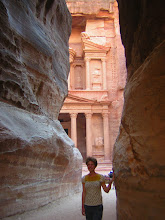It's lucky, I think, that Semarang has a nice personality, because physically it has little to offer. Most of its architecture follows the always-in-vogue "decrepit modern" style, meaning that Semarang could probably make a fortune by selling itself to moviemakers as "Generic Southeast Asian City #22" and appearing in hundreds of films as Bangkok, Jakarta, Manila, or Hanoi. Although Semarang is the capital of the province of Central Java, it is mainly a commercial and administrative city, and is in no way the capital of Javanese culture. It boasts few real tourist attractions; the Lonely Planet Indonesia devotes two pages to Semarang, in contrast to its 12 pages about Yogyakarta or 10 pages about Solo, a city one-third Semarang's size. (More embarassing still, a good half a page of those two is devoted to detailing how to get to Yogyakarta or Solo from Semarang.) Moreover, the tourist guidebooks published by Semarang's regional government itself fail to elaborate on Lonely Planet's assessment; one pamphlet I saw today listed five tourist attractions, two of which were shopping centers and two of which were government buildings. The final pages of the pamphlet then listed the prices of trains, buses, and airplanes out of the city. (This seems like an admission of defeat to me; perhaps, if the city officials were so inclined, they could change the city motto to "From Here You Can Go Anywhere (In Central Java)!")
Today, though, determined to use my Wednesdays off in a productive manner (I get Wednesday off. Wednesdays. Fridays would be one thing, or maybe Monday, but what on earth can I do with Wednesday off?), I set off to be a tourist in Semarang. Armed with my Lonely Planet knowledge (too lazy to carry such a big book for only two pages, I simply memorized the info), I started walking. I could have accepted any number of a thousand and one offers to ride a becak, but I figured, what else would I do with my time but walk? I had, after all, an entire day to fill, and only about twenty minutes of actual tourist activity with which to fill it. So thus, like a mad dog or Englishman, I spent the hottest hours of the day, from about ten to three, slowly strolling down the city's biggest streets.
I had another reason for walking, of course. I hoped that, if I only moved slowly enough, I would see hidden depths and charms in this place, Yogyakarta's ugly (Chinese) stepsister. I might happen upon a tiny alley filled with cultural wonders, or maybe luck into an old traditional building of some kind, or maybe even find some hidden spot that Lonely Planet missed.
Well, there's luck and then there's luck. In my five hour excursion, I found, as Lonely Planet predicted, mostly shops and government buildings. I saw a few statues; Semarang, like Jakarta, boasts a rockin' collection of Communist era statues to heroes and battles. I stumbled into a public library, where a handsome young librarian in a pseudo-military uniform gave me water to drink and urged me to return again anytime. I wandered through the city's largest traditional market, terrified the whole time, as my host father told me a long story last night about being robbed at knife point there. (I escaped with camera, money, and life intact.) I fended off a thousand shouts of "hello Mister" and "I love you beautiful!" (Interestingly, I get fewer shouts and stares in Semarang than Jakarta. I'm not sure why.) All in all, no hidden gems, but a thoroughly enjoyable, if overheated, sort of day.
If you're good with counting, though, you may have noticed that Semarang has five tourist attractions, and only four are shopping centers or government buildings. The fifth puts those mundane sights to shame. In the colonial era, Semarang was also a provincial capital for the Dutch, who tried hard to build it up to rival Batavia (now Jakarta). Unlike in Jakarta, however, a lot of the old architecture still exists in an area of Semarang still known by the Dutch name, "Oudstad," or "old city." (The Dutch name, though common, is also commonly misspelled; it appears as outstadt, oudstad, outstad, and nearly any other variation you can think of.)
This old city, unlike the rest of Semarang, is really quite beautiful. It is bordered by a canal, slow and dirty, and crossing the bridge over the canal is like entering another world: the streets are wide and still paved with cobbles, the buildings are white and decorated with balconies and arches, and small white lampposts line the roads. The entire area looks, not surprisingly, like a faded tropical ghost of Amsterdam. The traffic slows a little in this neighborhood, so everything's a little quieter, and it's not hard to imagine this area two hundred years ago, with Dutch administrators and their wives riding the becaks, instead of sweating American tourists. I almost felt, passing the area's famous Gereja Blenduk, a Dutch church built in 1753, that I ought to be wearing white linen and carrying a parasol.
I'll save that for next time, I suppose. For now, though, I'm just pleased to know that Semarang can offer at least one decent tourist attraction for all those out there who need a reason to come visit me. (If for some strange reason you need another, I can guarantee that it's easy to find a train, bus, or airplane to Yogyakarta or Solo.)
Subscribe to:
Post Comments (Atom)

3 comments:
You could have T-shirts made: ""Semarang: a good to place to get from""
Your aunts and uncles read your blog but they don't know how to post comments. Your Mama too
This reminds me of Indiana's state motto, Crossroads of America, i.e., "Where you go on your way to somewhere else."
I'll come visit you!! I am new to Salatiga and slightly bored!!! Find me on FB at Heidi Wenger.
Post a Comment